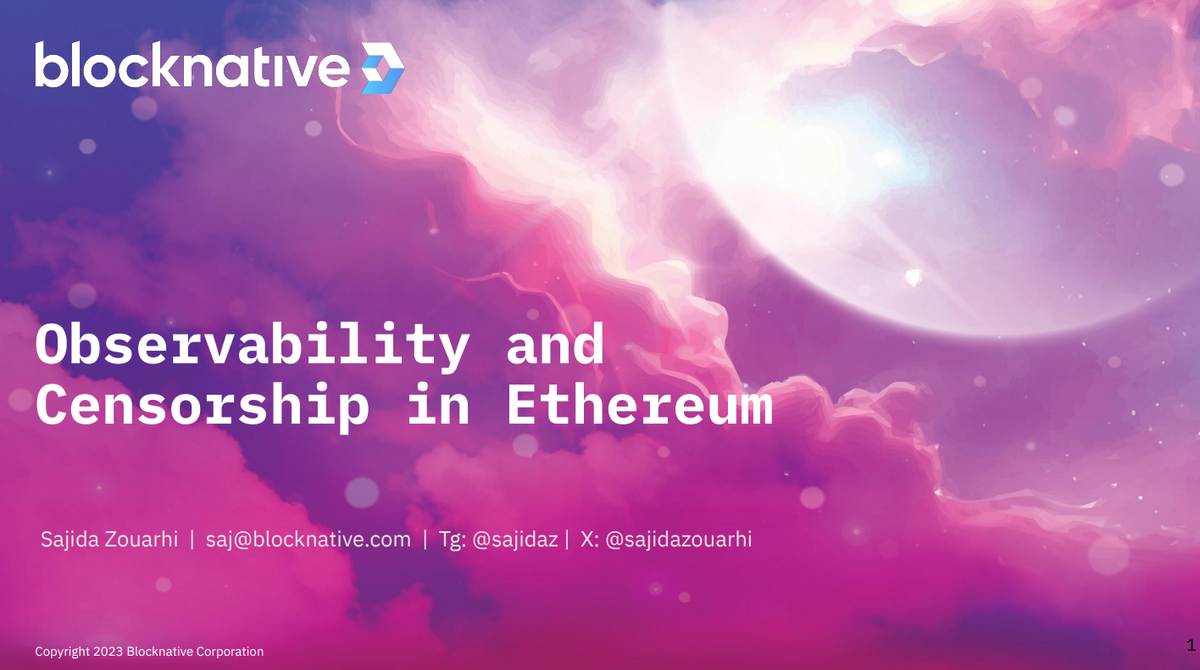Observability and Censorship in Ethereum - Censorship.wtf
Source : https://www.youtube.com/watch?v=WcJlseuhbX8

Censorship on Ethereum, a regolatory matter ?




Blocknative had been working on relays and block building operations for at least 9 months until they suspended that work. They are now focused on illuminating more about what's happening in the MEV supply chain.
When talking about censorship, the focus is often on OFAC compliancy, which was a big issue last year. In particular, there was some centralization going on with one relay, Flashbots, being dominant and OFAC compliant, meaning it was enforcing compliance across Ethereum.
At one point around 80% of Ethereum was served by Flashbots, and 80% of Flashbots blocks came from one provider.
Monitoring and transparency allowed the community to identify the censorship threat and take action. Now the situation has improved with emergence of new non-censoring relays like BloXroute.
Block Builders (2:20)


The power has shifted from validators to builders in a PBS (Proposer-Builder Separation) world. Builders now decide block content, shaded or not.
Successful builders are mostly integrated searchers/high frequency traders who profit from MEV at transaction and block levels. MEV by manipulating transaction order could be seen as a form of censorship.
Integrated, profitable builders are likely to continue dominating compared to neutral builders. Currently ~82% of Ethereum blocks are built by just 3 main builders, showing high centralization.
With centralization, censorship pressure can come from within, not just regulations. The pre-chain layer helps reveal actor behaviors.
It's hard to enforce good behavior with limited observability and complex strategies. If censorship happens, intentionally or not, there is little recourse, especially if unaware.
The need for observability in Ethereum (4:40)



Private transactions have become more popular, including OFAs with capabilities like refunds and privacy via hinting.
However, some OFA users don't get the financial value they should, e.g. fast settlement or best outcomes. Some written guarantees are not respected, and important info can be left out of docs.
- Who is watching out for these issues ?
- Should we accept the status quo if no one is ?
In the OFA supply chain, transactions go to OFA nodes first before block builders. We need to trust several actors shown in pink, especially the OFA-block builder interaction where observability is limited.
Without observability there needs to be trust, which is problematic from a system design perspective.
A practical case study (6:45)




A case study looked at Transaction Boost, an aggregator sending private transactions to RPC endpoints :
A user sent 5000+ transactions via Boost to Flashbots only, but transactions landed in blocks of top 5 builders.
The user got refunds from 4 builders but not the 5th, which won 20% of blocks with the user's transactions.
Analysis with Hindsight library identified 19 transactions that could have gotten refund but didn't. It's the builder's backrunning bot which claimed them instead.
The user missed out on potential refunds and would never have known without this analysis.
Is there an information advantage for vertically integrated searcher (builder+searcher) on MEV-Share compared to just a searcher ?
The actual MEV supply chain (9:15)


At first glance, we can think that builders are taking advantage from the lack of monitoring capabilities. But the plot thickened.
It's unclear if this was intentional/accidental censorship by the builder or if Flashbots even sent the bundles, as there's no way to know if the builder received the bundles. The builder would refund bundles, or ignore them as well.
There is no OFA builder equivalent to the relayed data API to see who received what and when. This would provide some clarity to the user and allows discussion, which is a first step.
More details are in a blog post, including other findings about interesting behaviors uncovered through analysis.
This demonstrates how much there is to still observe and understand to improve the ecosystem
The need for more observability (10:40)


More observability is needed on the MEV supply chain for privacy and maintaining user trust. Less observability means more trust reliance and inability to identify issues.
However, observing mempools is challenging due to fragmentation, distribution, and constant change. Accurate data compilation and analysis of sophisticated actors is difficult.
Observability solutions must align with transparency and inclusiveness goals, unlike traditional finance where some leverage info advantages.
Blocknative is actually building an open source observability platform called Mempool Explorer, which visualizes mempool in real time.